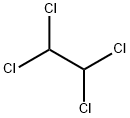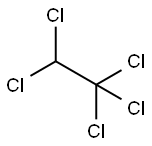1,1,2,2-tetrachloroethane , AR,98% , 79-34-5
Synonym(s):
1,1,2,2-Tetrachloroethane;Acetylene tetrachloride
CAS NO.:79-34-5
Empirical Formula: C2H2Cl4
Molecular Weight: 167.85
MDL number: MFCD00000848
EINECS: 201-197-8
PRODUCT Properties
| Melting point: | -43 °C |
| Boiling point: | 147 °C(lit.) |
| Density | 1.586 g/mL at 25 °C(lit.) |
| vapor density | 5.8 (vs air) |
| vapor pressure | 8 mm Hg ( 20 °C) |
| refractive index | n |
| Flash point: | 142-146°C |
| storage temp. | Store below +30°C. |
| solubility | 2830g/l |
| form | Liquid |
| color | slightly green-yellow |
| Water Solubility | 0.3 g/100 mL (25 ºC) |
| Merck | 14,9189 |
| BRN | 969206 |
| Henry's Law Constant | 6.22 at 30 °C (headspace-GC, Sanz et al., 1997) |
| Exposure limits | Potential occupational carcinogen. NIOSH REL: TWA 1 ppm (7 mg/m3), IDLH
100 ppm; OSHA PEL: TWA 5 ppm (35 mg/m3); ACGIH TLV: TWA 1 ppm (adopted). |
| Dielectric constant | 8.4199999999999999 |
| Stability: | Stable. Incompatible with strong oxidizing agents, strong bases. Reacts violently with sodium, potassium, nitrates, 2,4-dinitrophenyl disulphide. |
| Surface tension | 35.50mN/m at 298.15K |
| CAS DataBase Reference | 79-34-5(CAS DataBase Reference) |
| IARC | 2B (Vol. 20, Sup 7, 71, 106) 2014 |
| NIST Chemistry Reference | Ethane, 1,1,2,2-tetrachloro-(79-34-5) |
| EPA Substance Registry System | 1,1,2,2-Tetrachloroethane (79-34-5) |
Description and Uses
1,1,2,2-Tetrachloroethane (tetrachloroethane) is a volatile, synthetic, colorless to pale-yellow dense liquid with a pungent, chloroform-like odor that is soluble in water and most organic solvents. There are no known natural sources of tetrachloroethane. Tetrachloroethane is a chemical intermediate in the production of a variety of other common chemicals. In the past, the major use for tetrachloroethane was in the production of trichloroethylene, tetrachloroethylene, and 1,2-dichloroethylene. With the development of new processes for manufacturing chlorinated ethylenes and the availability of less-toxic solvents, the production of tetrachloroethane as a commercial endproduct in the United States and Canada has steadily declined since the late 1960s and the production ceased by the early 1990s. Although at one time it was used as an insecticide, fumigant, and weed killer, it presently is not registered for any of these purposes. Its registration as an insect repellent was canceled by the Environmental Protection Agency (EPA) in the late 1970s.
1,1,2,2-Tetrachloroethane, once used as a solvent for cleaning and extraction processes, is still used to some extent as a chemical intermediate. Present usage is quite limited because less toxic solvents are available.
Safety
| Symbol(GHS) |   GHS06,GHS09 |
| Signal word | Danger |
| Hazard statements | H310+H330-H411 |
| Precautionary statements | P262-P273-P280-P302+P352+P310-P304+P340+P310 |
| Hazard Codes | T+,N,T,F |
| Risk Statements | 26/27-51/53-59-39/23/24/25-23/24/25-11 |
| Safety Statements | 38-45-61-36/37-16-7 |
| OEB | B |
| OEL | TWA: 1 ppm (7 mg/m3) [skin] (Chloroethanes) |
| RIDADR | UN 1702 6.1/PG 2 |
| WGK Germany | 3 |
| RTECS | KI8575000 |
| TSCA | Yes |
| HS Code | 2903 19 00 |
| HazardClass | 6.1 |
| PackingGroup | II |
| Hazardous Substances Data | 79-34-5(Hazardous Substances Data) |
| Toxicity | LD50 orally in rats: 0.20 ml/kg (Smyth) |
| IDLA | 100 ppm |


